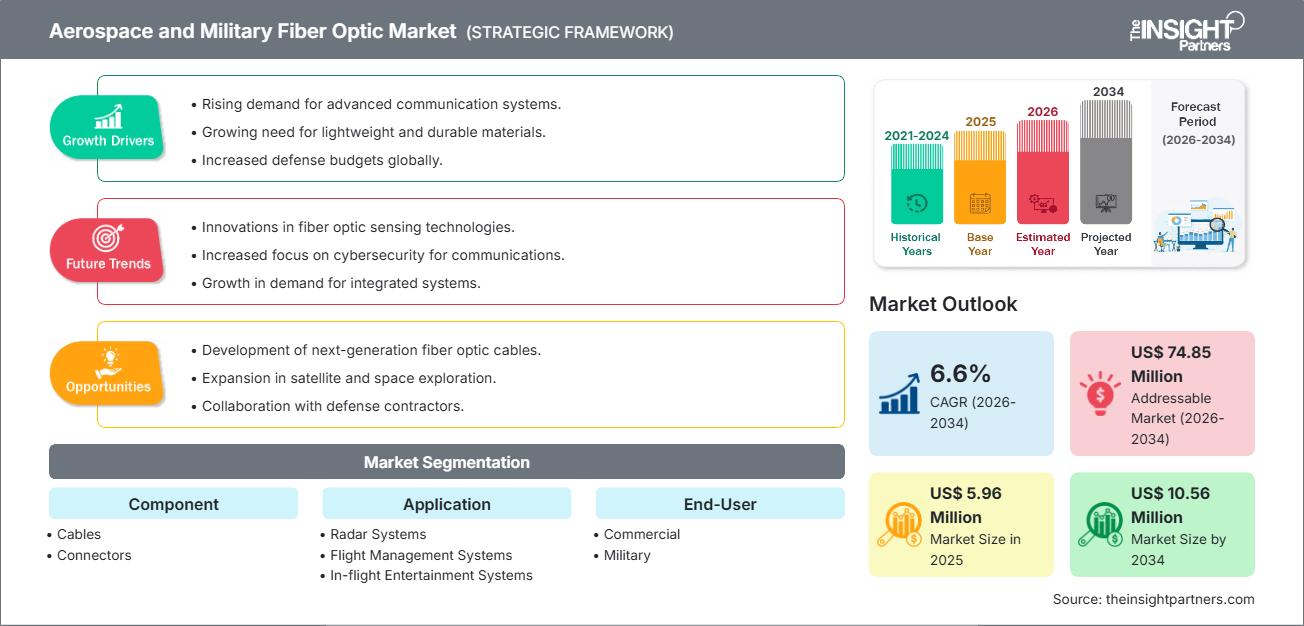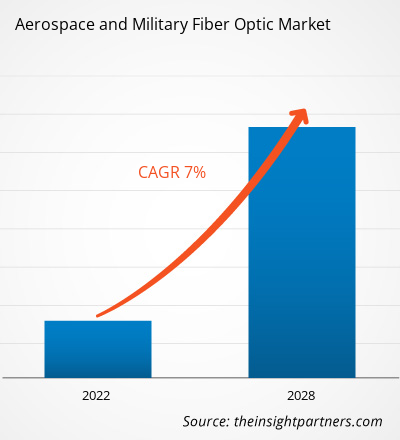预计到2034年,航空航天和军用光纤市场规模将从2025年的596万美元增长至1056万美元。预计该市场在2026年至2034年期间的复合年增长率将达到6.6%。
航空航天和军用光纤市场分析
市场预测显示,市场将呈现强劲增长势头,主要驱动力来自现代国防和航空航天平台对安全、高速、低延迟数据传输的迫切需求。飞机和无人机(UAV)对轻量化的迫切需求加速了市场扩张,轻质光纤电缆取代了较重的铜缆,从而提高了燃油效率并增加了有效载荷能力。此外,大规模的国防现代化计划以及航空电子设备和电子战系统日益复杂化,也推动了对先进、坚固耐用的光纤组件的需求。
航空航天和军用光纤市场概览
光纤技术是注塑成型系统中的关键技术,它能确保多个区域均匀加热,从而维持最佳熔体流动。对于军事和航空航天应用而言,光纤凭借其卓越的数据吞吐量、抗电磁干扰 (EMI) 能力以及相比传统铜线更高的安全性,不可或缺。这些系统是 C4ISR(指挥、控制、通信、计算机、情报、监视和侦察)、雷达和飞行管理系统等关键任务应用中的必要组件。光纤能够提供可靠的数据链路,即使在极端环境下也能稳定运行,是商用和军用平台实现高精度操作和安全数据传输的基石。
根据您的需求定制此报告
您可以免费获得任何报告的定制服务,包括本报告的部分内容、国家/地区层面的分析、Excel 数据包,以及面向初创企业和高校的优惠折扣。
航空航天和军用光纤市场:战略洞察

-
获取本报告的主要市场趋势。这份免费样品将包含数据分析,内容涵盖市场趋势、估算和预测等。
航空航天和军用光纤市场驱动因素和机遇
市场驱动因素:
- 对高速数据和带宽的需求不断增长:现代军事和商业平台(例如,第五代战斗机、卫星)需要超高带宽来支持来自复杂传感器阵列的数据融合和实时处理。
- 系统减重需求:光纤电缆显著减轻了机载线束的重量,直接提高了飞机的燃油效率和有效载荷能力。
- 抗电磁干扰 (EMI):光纤传输的是光而不是电信号,因此具有固有的抗电磁干扰能力,这对于雷达和电子战设备附近的系统以及抵御电磁脉冲攻击至关重要。
- 国防现代化和新飞机采购:全球国防预算和不断增加的新商用飞机订单(采用先进的航空电子设备)推动了光纤系统的集成。
市场机遇:
- 自主系统(无人机/无人地面车辆)的扩散:无人系统严重依赖低延迟、高速光纤链路进行远程控制、传感器反馈和协调任务。
- 先进光纤传感器的集成:采用光纤陀螺仪 (FOG) 进行精确导航,采用分布式声波传感 (DAS) 进行周界安全,具有巨大的增长潜力。
- 量子安全通信的发展:利用光纤线路进行量子密钥分发 (QKD) 可提供几乎无法破解的加密,为关键军事通信网络创造了高价值的机会。
- 小型化和加固化:小型化、加固型和高密度连接器和电缆的不断创新,扩大了其在受限和恶劣的军事/太空环境中的应用范围。
航空航天和军用光纤市场报告细分分析
本报告对航空航天和军用光纤市场份额进行了多维度分析,旨在更清晰地展现其结构、增长潜力及新兴趋势。以下是大多数行业报告中常用的标准细分方法:
按组件:
- 电缆
- 连接器:
组件部分构成了市场的基础,其驱动力源于对高速、安全数据通道的迫切需求。根据应用的不同,电缆通常采用单模或多模设计,以满足严苛的环境压力;而扩束连接器和气密封装连接器则用于为航空航天和国防领域的关键任务系统提供可靠、低损耗的互连。
按申请方式:
- 雷达系统
- 飞行管理系统
- 机上娱乐系统
- 通信系统
- 电子战
- 客舱内部
- 航空电子设备。
应用领域对于确定市场需求至关重要。通信系统(其次是航空电子设备)占据最大市场份额,这主要得益于空中、陆地和海上平台对可靠、高带宽通信的需求,以支持实时C4ISR和先进导航。
按最终用户:
- 商业航空航天:光纤技术为现代机上娱乐和先进的飞行管理系统提供了可能,既减轻了飞机的整体重量,又支持了复杂的乘客通信服务。
- 军事与国防:最大的终端用户,要求战术通信、导弹制导和电子战 (EW) 系统具备高可靠性、坚固耐用的光纤,并且必须能够抵御电磁威胁。
按地理位置:
- 北美
- 欧洲
- 亚太地区
- 南美洲和中美洲
- 中东和非洲
受中国和印度等国国防现代化进程加快和商用飞机机队大规模扩张的推动,亚太地区的航空航天和军用光纤市场预计将在预测期内实现最快增长。
航空航天和军用光纤市场区域洞察
The Insight Partners 的分析师对预测期内航空航天和军用光纤市场的区域趋势和影响因素进行了详尽的阐述。本节还探讨了北美、欧洲、亚太、中东和非洲以及南美和中美洲等地区的航空航天和军用光纤市场细分及地域分布。
航空航天和军用光纤市场报告范围
| 报告属性 | 细节 |
|---|---|
| 2025年市场规模 | 596万美元 |
| 到2034年市场规模 | 1056万美元 |
| 全球复合年增长率(2026-2034 年) | 6.6% |
| 史料 | 2021-2024 |
| 预测期 | 2026-2034 |
| 涵盖部分 |
按组件
|
| 覆盖地区和国家 |
北美
|
| 市场领导者和主要公司简介 |
|
航空航天和军用光纤市场参与者密度:了解其对业务动态的影响
航空航天和军用光纤市场正快速增长,这主要得益于终端用户需求的不断增长,而终端用户需求的增长又源于消费者偏好的转变、技术的进步以及对产品优势认知的提高。随着需求的增长,企业不断拓展产品和服务,持续创新以满足消费者需求,并把握新兴趋势,这些都进一步推动了市场增长。

- 获取航空航天和军用光纤市场主要参与者概览
按地域划分的航空航天和军用光纤市场份额分析
预计未来几年亚太地区将实现最快增长。南美和中美洲、中东和非洲等新兴市场也为光纤系统供应商提供了许多尚未开发的扩张机会。
受国防开支、飞机现代化周期和严格的监管环境等因素影响,航空航天和军用光纤市场在各个地区的增长轨迹各不相同。以下是各地区市场份额和趋势概述:
-
北美
- 市场份额:凭借先进的国防制造技术和大量的研发投入,占据了主导市场份额。
-
关键驱动因素:
- 光纤在先进平台(例如F-35战斗机、无人机)中的广泛应用
- 用于军事C4ISR和监视的高额预算拨款
- 主要航空航天原始设备制造商的参与
- 趋势:转向高密度、抗辐射加固的光纤用于空间和卫星通信;重点关注量子密钥分发(QKD)以实现超安全的军事链路。
-
欧洲
- 市场份额:强大的市场地位,这得益于关键的国防项目和系统安全方面的监管要求。
-
关键驱动因素:
- 严格遵守材料标准(例如 REACH 和 RoHS)
- 未来作战空中系统(FCAS)等重大国防计划
- 光纤陀螺仪(FOG)需求量大
- 趋势:下一代战斗机和海军舰艇越来越注重小型化和减轻重量;舰载雷达和电子战系统更多地采用光纤。
-
亚太地区
- 市场份额:增长最快的地区,这得益于国防现代化进程的快速推进和商业船队的迅猛扩张。
-
关键驱动因素:
- 政府支持的本土国防生产计划
- 来自中国和印度的巨额商用飞机订单
- 对海军和海上监视的投资不断增长
- 趋势:多模和单模电缆被广泛采用,以实现经济高效、高输出的通信系统;发展本地制造能力以满足区域需求。
-
南美洲和中美洲
- 市场份额:新兴市场,国防升级方面的投资不断增长。
-
关键驱动因素:
- 扩大当地航空航天制造能力(例如,巴西)
- 老旧机队需要高效的航空电子解决方案。
- 国防技术转让的公私合作关系
- 趋势:地面通信网络越来越多地采用加固型战术光纤;重点关注用于国防应用的成本效益高、经久耐用的光纤解决方案。
-
中东和非洲
- 市场份额:由于国防和航空航天基础设施支出不断增加,该市场具有强劲的增长潜力。
-
关键驱动因素:
- 国防多元化项目(例如沙特阿拉伯、阿联酋)
- 战略地理位置推动军事和空中交通投资
- 对边境和关键基础设施安全的需要。
- 趋势:实施基于光纤的分布式声波传感 (DAS) 以保障周界安全;投资于需要安全、高带宽骨干网的集成监控和 C4ISR 系统。
航空航天和军用光纤市场参与者密度:了解其对业务动态的影响
市场密度高,竞争激烈
由于卡莱尔互连技术公司、安费诺公司和泰科电子等全球主要供应商的参与,市场竞争日益激烈。区域性专业公司和专注于特定领域的光纤技术公司也对市场格局做出了贡献。
这种竞争环境促使供应商通过以下方式实现差异化:
- 技术领先:专注于小型化、抗辐射(用于太空)和超轻型解决方案的研发,以满足严格的行业标准(例如 F-35 项目)。
- 产品加固:开发高度耐用的电缆组件和连接器(例如,扩束连接器),使其能够在极端的机械冲击、振动和温度变化下可靠地工作。
- 战略伙伴关系:与大型国防承包商和军事机构合作,将下一代光学解决方案整合到长期国防计划中(例如,未来作战空中系统)。
- 系统集成:为飞机和国防平台制造商提供无缝、预端接的光纤线束和连接解决方案,从而降低安装复杂性并加快产品上市速度。
在航空航天和军用光纤市场运营的主要公司有:
- 卡莱尔互连技术公司
- 安费诺公司
- 雷神技术公司
- 普睿司曼集团
- ITT公司
- TE Connectivity
- 美国劳工联合会
- Timbercon公司
- 耐克森集团
免责声明:以上列出的公司不分先后顺序。
航空航天和军用光纤市场新闻及最新动态
- 安费诺收购卡莱尔互连技术公司:领先的航空航天和国防严苛环境互连解决方案供应商卡莱尔互连技术公司(CIT)宣布,已与安费诺公司达成收购协议,收购金额约为20.25亿美元。该交易预计将于2024年第二季度完成,将增强安费诺在商用和军用平台上的光纤能力。
- 安费诺推出坚固型光纤收发器:安费诺有源光器件公司推出了一系列高速坚固型收发器,包括 SCFF 1-TRX 10G/25G 和 FiberQuad,专为严苛的航空航天和国防应用而设计。这些解决方案的单通道数据速率高达 28 Gbps,可支持先进的雷达和航空电子系统。
- 雷神技术公司获得DARPA量子传感器合同:雷神公司的BBN技术公司获得DARPA合同,将利用压缩光开发光子芯片级量子传感器,预计这将使用于军事应用的基于光纤的传感和导航系统的灵敏度提高10倍。
航空航天和军用光纤市场报告涵盖范围和交付成果
《航空航天和军用光纤市场规模及预测(2021-2034)》报告对市场进行了详细分析,涵盖以下领域:
- 航空航天和军用光纤市场规模及预测,涵盖全球、区域和国家层面的所有关键市场细分,包括组件、应用、最终用户和平台类型。
- 航空航天和军用光纤市场趋势,以及影响行业增长的市场动态,例如驱动因素、制约因素和关键机遇。主要因素包括对高速、安全数据传输的需求不断增长、轻量化系统设计以及军用和航空航天机队的现代化改造。
- 详细的 PEST 和 SWOT 分析,深入剖析塑造市场格局的政治、经济、社会和技术力量。
- 航空航天和军用光纤市场分析涵盖关键市场趋势、全球和区域框架、主要参与者、国防采购标准以及航空航天和军用通信网络的最新技术发展。
- 行业格局和竞争分析,涵盖航空航天和军用光纤市场的市场集中度、热力图分析、主要参与者和战略发展。
- 详细介绍公司概况,包括业务概览、产品组合、近期合同、合作伙伴关系和财务亮点(如有),涵盖安费诺公司、TE Connectivity、卡莱尔互连技术公司、雷神技术公司和康宁公司等领先企业。
- 历史分析(2 年)、基准年、预测(7 年)及复合年增长率
- PEST和SWOT分析
- 市场规模、价值/数量 - 全球、区域、国家
- 行业和竞争格局
- Excel 数据集
近期报告
客户评价
购买理由
- 明智的决策
- 了解市场动态
- 竞争分析
- 客户洞察
- 市场预测
- 风险规避
- 战略规划
- 投资论证
- 识别新兴市场
- 优化营销策略
- 提升运营效率
- 顺应监管趋势






















 获取免费样品 - 航空航天和军用光纤市场
获取免费样品 - 航空航天和军用光纤市场